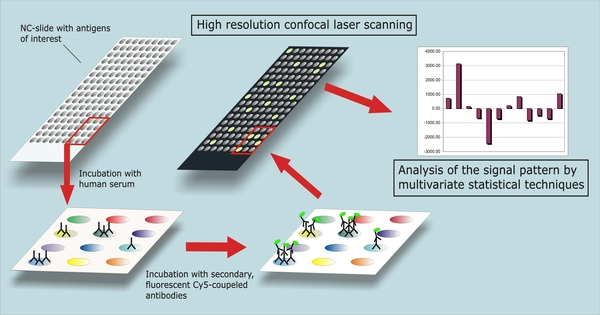A protein microarray is a useful technique used in proteomics and molecular biology to examine many proteins at the same time in a high-throughput manner. It is a high-throughput approach for tracking the interactions and activities of proteins and determining their function on a wide scale. It is conceptually similar to DNA microarrays, which are used to evaluate gene expression.
Its key advantage is that it can track a huge number of proteins at the same time. A protein microarray is a spatially specified array of proteins immobilized on a solid surface, such as a glass slide or a membrane. A glass slide, nitrocellulose membrane, bead, or microtitre plate serves as the chip’s support surface, on which an array of capture proteins is coupled. These microarrays can then be used by researchers to investigate numerous aspects of protein biology, such as protein-protein interactions, protein expression levels, and protein function.
Protein microarrays were originally introduced and demonstrated in antibody microarrays (also known as antibody matrix) in a scholarly journal and a set of patents in 1983. The protein microarray’s high-throughput technology was relatively simple to build because it is based on the technology developed for DNA microarrays, which have become the most extensively used microarrays.
Here are some key aspects of protein microarrays:
- Protein Immobilization: Proteins of interest are immobilized onto the microarray surface, usually in a specific pattern or grid. This immobilization can be achieved through various techniques, including printing, spotting, or direct synthesis, depending on the specific microarray platform.
- Sample Binding: The protein microarray can then be exposed to a sample of interest, such as cell lysates, serum, or other biological fluids. Proteins in the sample will bind to their immobilized counterparts on the microarray.
- Detection: To visualize the attached proteins, many detection methods can be applied. Depending on the needs of the experiment, common detection methods include fluorescent labels, chemiluminescent markers, or radioactive isotopes.
- Data Analysis: Data analysis software is used to quantify the quantity of protein binding once the microarray has been scanned or digitally photographed. This information can help researchers understand protein-protein interactions, protein expression levels, and protein function.
Protein microarrays have a wide range of applications, including:
- Protein-Protein Interaction Studies: Researchers can identify interactions between proteins by examining which proteins bind to one another on the microarray.
- Antibody Profiling: Protein microarrays can be used to screen for the presence of specific antibodies in patient serum, which can be valuable for diagnostic and serological studies.
- Protein Expression Profiling: Researchers can analyze the amounts of individual proteins in a sample by measuring its binding to an array of known proteins, which helps to quantify their expression.
- Drug Discovery: It can be used to screen for prospective therapeutic candidates by examining the effects of different compounds on protein binding and activity.
Protein microarrays have become indispensable tools in both basic research and clinical applications, allowing for the simultaneous study of many proteins at a high throughput and cheap cost. They have made major contributions to our understanding of protein biology and have the potential to influence sectors such as personalized medicine and medication development.
















